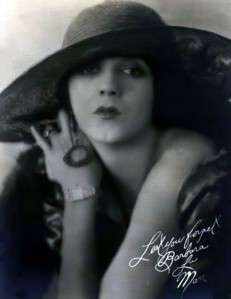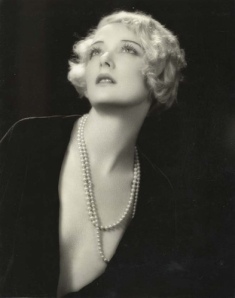I’m always delighted when someone takes the time to read my books. I’m thrilled when they take the time to review them and give their opinions of my work. Dangerous Curves was a super fun book to research. I’m working on a companion volume to be released in early 2014.
Here are the two recent reviews of Dangerous Curves.
Dangerous Curves atop Hollywood Heels: The Lives, Careers, and Misfortunes of 14 Hard-Luck Girls of the Silent Screen [Paperback]
“Amazingly Unusual”
Michael G. Ankerich BearManor Media (December 5, 2010)
“We were like dragonflies. We seemed to be suspended effortlessly in the air, but in reality, our wings were beating very, very fast.” – Mae Murray “It is worse than folly for persons to imagine that this business is an easy road to money, to contentment, or to that strange quality called happiness.” – Bebe Daniels “A girl should realize that a career on the screen demands everything, promising nothing.” – Helen Ferguson In Dangerous Curves Atop Hollywood Heels, author Michael G. Ankerich examines the lives, careers, and disappointments of 15 silent film actresses, who, despite the odds against them and warnings to stay in their hometowns, came to Hollywood to make names for themselves in the movies. On the screen, these young hopefuls became Agnes Ayres, Olive Borden, Grace Darmond, Elinor Fair, Juanita Hansen, Wanda Hawley, Natalie Joyce, Barbara La Marr, Martha Mansfield, Mae Murray, Mary Nolan, Marie Prevost, Lucille Ricksen, Eve Southern, and Alberta Vaughn. Dangerous Curves follows the precarious routes these young ladies took in their quest for fame and uncovers how some of the top actresses of the silent screen were used, abused, and discarded. Many, unable to let go of the spotlight after it had singed their very souls, came to a stop on that dead-end street, referred to by actress Anna Q. Nilsson as, Hollywood’s Heartbreak Lane. Pieced together using contemporary interviews the actresses gave, conversations with friends, relatives, and co-workers, and exhaustive research through scrapbooks, archives, and public records, Dangerous Curves offers an honest, yet compassionate, look at some of the brightest luminaries of the silent screen. The book is illustrated with over 150 photographs.
Dangerous Curves atop Hollywood Heels: The Lives, Careers, and Misfortunes of 14 Hard-Luck Girls of the Silent Screen (Paperback)
My bookcase is full of books by William Drew, Anthony Slide, Eve Golden, and so many bios and autobiographys but in Dangerous Curves I read about 14 silent stars and eleven of them I never heard of. Yet, these women were stars who made several movies, they were not in the Mary Pickford or Gloria Swanson class, but they were stars none the less.
I wish that I were an English major so that I could write a review that would really stand out and get people to purchase this terrific book. The stories are so compleling and so many are heartbreaking. He was lucky enough to interview Barbara LaMarr’s son and there are new facts concerning her that have never been published. In everything I had ever read, including Jimmy Bangley’s piece in Screen Classic, it was said that she was adopted. Turns out that she wasn’t and that she had siblings, including a sister (and her boyfriend) who try to kidnap her.
The research on this book was extensive and this made the book so incredibly wonderful. If you are at all interested in silent film history, this is a “must have” and even if you aren’t, the stories of these ladies will really hold your interest.

Here is the other one: http://tarahanks.com/2012/08/01/dangerous-curves-atop-hollywood-heels/
Dangerous Curves Atop Hollywood Heels
August 1, 2012 by marina72

Dangerous Curves Atop Hollywood Heels: The Lives, Careers and Misfortunes of 14 Hard-Luck Girls of the Silent Screen is an illustrated paperback by Michael G. Ankerich, published in 2010 by BearManor Media, and named by the San Francisco Examiner as one of the top silent film books of that year.
Ankerich’s previous books on early cinema include two collections of interviews,Broken Silence and The Sound of Silence; and a biography, The Real Joyce Compton.
‘Cultivate your curves,’ Mae West once quipped. ‘They may be dangerous, but they can’t be avoided.’ Of all the hard-luck stories of the silver screen, the earliest are among the most poignant.
Hollywood was a provincial backwater when D.W. Griffith expanded his Biograph company from New York to California in 1910. Within a decade, America’s film industry was booming. However, scandals involving stars like Fatty Arbuckle and Mabel Normand led to an increasing unease with the popularity of movies.
In 1921, Will Hays became head of the Motion Picture Producers and Directors Association, and gradually a strict moral code was imposed. This didn’t stop stars misbehaving off-screen, of course, but the magazine columnists of the day were ready to report every little mishap.
If the careers of movie actors weren’t precarious enough already, advances in technology posed another threat. Many skilled and experienced stars fell by the wayside in the late 1920s, brought down by their own peccadilloes and the coming of sound.

Ankerich avoids the best-known silent stars – such as Clara Bow or Louise Brooks, whose fates have been well-documented – in favour of those who are now all but forgotten. Of these, the most recognisable is Barbara LaMarr – dubbed ‘The Girl Who Was Too Beautiful.’
This monicker originated from when she was still a teenager in trouble with the law. Returning her to her parents’ care, the judge declared that, ‘There are no charges against (her) – unless it be that she is dangerously beautiful.’ She quickly became immersed in the nightlife of Los Angeles and New York, admitting that she rarely slept for more than two hours.
Barbara had a gift for poetry and was working as a scenarist when Mary Pickford encouraged her to take up acting. In 1922, she starred alongside Ramon Navarro in The Prisoner of Zenda. She bore a son in secret, later adopting him.
When Barbara died of tuberculosis at thirty, film producer Paul Bern arranged her funeral, remarking that she was ‘too beautiful to cremate.’ Her son was raised by actress ZaSu Pitts. Her surname would later be given to another beautiful brunette, Hedy Lamarr.

Marie Prevost began her career as a ‘bathing beauty’ in Mack Sennett’s two-reeler slapstick comedies. After being snapped up by Universal’s Irving Thalberg, Marie burned her bathing suit on Coney Island.
After finding new fame in The Married Flapper (1922), Marie appeared in three films directed by the great Ernst Lubitsch; The Marriage Circle and Three Womenin 1924, and Kiss Me Again in 1925. That year, she scored another hit withBobbed Hair.
But Marie’s life was dogged by tragedy. Shortly after she was dropped by Warners in 1926, Marie learned that her beloved mother had died in a car crash. When her own car later hit a young girl (who was unharmed), a haunted Marie began drinking heavily.
By the late 1920s, Marie’s weight gain was hindering her from winning roles. Her final star vehicle was Cecil B. DeMille’s The Godless Girl in 1929. Still, she never gave up, and for several years she worked as a contract player for MGM.
Her comeback was cut short in 1937, when Marie died in a house-fire. She wasn’t found for three days. Her friend, Joan Crawford, paid for her funeral, which was attended by many Hollywood luminaries. Crawford lamented that they had not been able to help Marie sooner.

Mary Nolan was born into dire poverty, and raised in an orphanage. At thirteen, she fled to New York and established herself as one of the leading artists’ models of the day, posing for the likes of Norman Rockwell.
She became involved with a married musical star, Frank Tinney, whose frequent beatings led her to attempt suicide. She was fired from the Ziegfeld Follies and moved to Europe. On her return to America in 1927 she changed her name to escape her sordid past.
In 1928, Mary achieved stardom in West of Zanzibar. Desert Nights, with John Gilbert, followed in 1930.But Mary was now embroiled in another abusive relationship, with MGM producer Eddie Mannix.
Addicted to narcotics, Mary became increasingly erratic. She was fired from What Men Want at Universal, and married a stockbroker who had just lost his $3 million fortune. After setting up a dress shop in New York, Mary went bankrupt and failed to pay her employees. She was jailed for thirty days.
Her final film was made in 1933. She tried to launch a new career as a nightclub singer, but was often in debt and spent time in a psychiatric ward. During the late 1940s, she sold her story to a tabloid newspaper. Then, in 1948, she died of a Seconal overdose. A sentimental poem was left at her bedside. Mary had written in the margin, ‘If only this were true.’

Juanita Hansen, like Marie Prevost, was one of Mack Sennett’s discoveries. After signing to Universal, she starred in serials like The Brass Bullet and The Lost City. But in 1918, while recovering from a serious bout of flu, Juanita began using narcotics to sustain herself during long working days.
Her last film was made in 1923. She credited Dr John Scott Barker with helping her to kick drugs. Unfortunately, she was arrested in a bust soon after, which she believed was a police set-up. When Dr Barker’s clinic was shot down, Juanita defended him in court.
She was devastated by the death of her friend, Mary Thurman, in 1925. Three years later, Juanita was badly scalded in a hotel shower.
When society beauty Evelyn Nesbit named Juanita as a co-respondent in her 1933 divorce from long-estranged husband Jack Clifford, she was once again plunged into scandal.
For the rest of her life, she worked tirelessly as an anti-drugs campaigner. Her 1938 book, The Conspiracy of Silence, argued that addicts should be given hospital treatment, not criminalised. In this respect, she was decades ahead of her time.
Though Juanita suffered an overdose during a brief relapse in 1941, she remained an inspiration to others until her death twenty years later.
Some of Ankerich’s stories are more light-hearted. Rudolph Valentino’s bride, Jean Acker, locked herself in her room on their wedding night, only surfacing when her alleged lover, Grace Darmond (star of The Valley of the Giants) arrived.
And in 1946, former silent screen star Alberta Vaughan was arrested while dancing in men’s underwear on the roadside for a bemused crowd of G.I.s, in exchange for cigarettes – only to repeat the spectacle in her jail cell, explaining, ‘A girl’s gotta smoke!’
Not all of the ‘hard-luck girls’ met a hapless fate. After taking advice from director Howard Hawks, Natalie Joyce declared, ‘I’ll never get anywhere in this business because I won’t put out!’ She later married and opened a beauty salon.
Eve Southern, whose acting career was cut short by a toboggan accident in 1932, continued to work behind the scenes as a retoucher, pianist and composer.
Dangerous Curves Atop Hollywood Heels illuminates a neglected area of cinematic history. If novelist Jacqueline Susann had been around in the 1920s,Valley of the Dolls would probably have read a little like this book.
Ankerich clearly knows his subject, adding a filmography and footnotes to each chapter. His next book, Mae Murray: The Girl With the Bee-Stung Lips, will be published in October, and he is currently writing a sequel to Dangerous Curves.

One response to ““Amazingly Unusual” : Two new reviews for Dangerous Curves Atop Hollywood Heels”
I just LOVE reading these Blogs and stories of these fascinating women,
Well done to all concerned !……………..and Keep sending me these wonderful stories, They are much Appreciated !